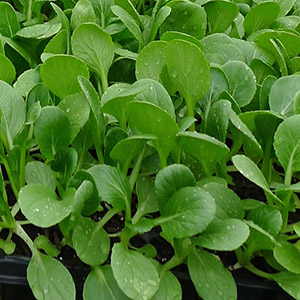
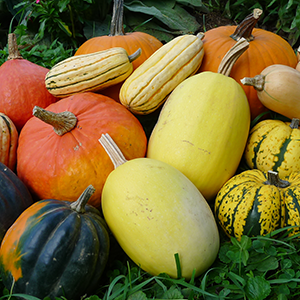
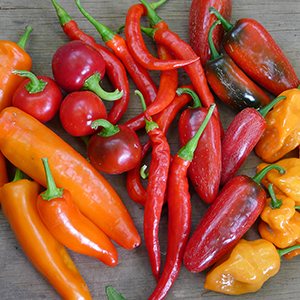

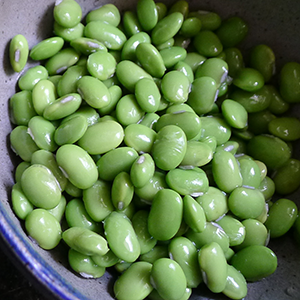
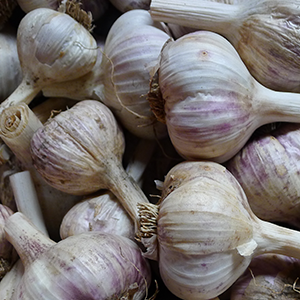
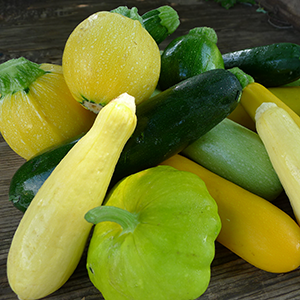



News and Notes | The Anchor Run Blog
Posts Filtered by Month - August 2020 |
Show Recent Posts
August 30, 2020
Workshifts for Week of 8/31/20
by Farmer Derek
Workshifts for Week of 8/31/20
by Farmer Derek
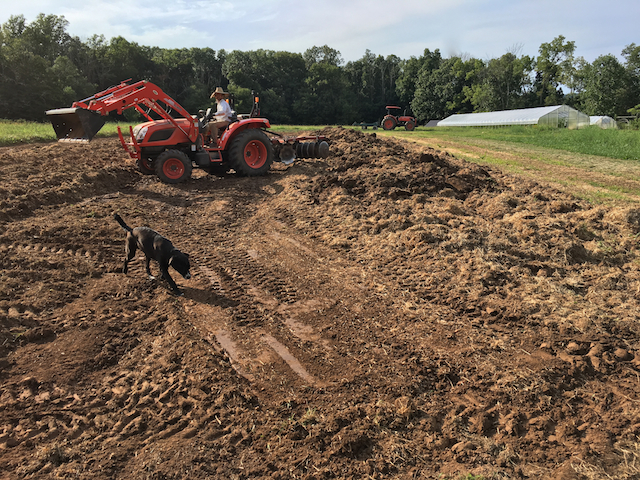
Excavating and grading water channels while using the soil to elevate and level the ground for our two new tunnels.
Workshifts will be held rain or shine. If it's raining we'll probably process garlic in the barn. When it's dry we'll probably harvest potatoes or pull some weeds.
Workshifts scheduled for this week:
- Tuesday 9/1 9-11am
- Wednesday 9/2 9-11am
- Friday 9/4 9-11am
- Sunday 9/6 8-10am

August 30, 2020
Summer's Slowly Fading
By Farmer Dana
Summer's Slowly Fading
By Farmer Dana
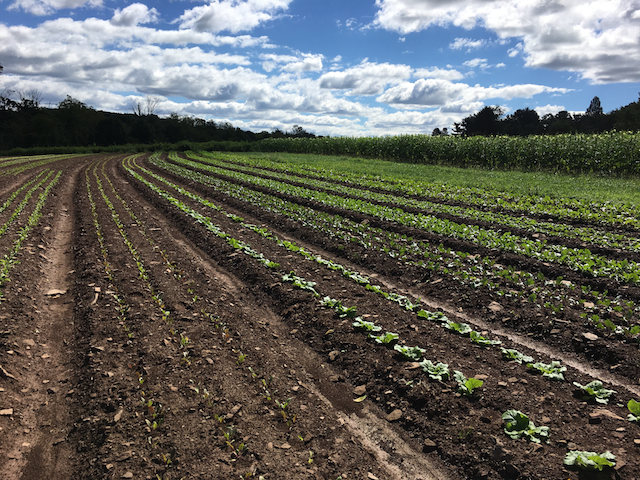
A sweeping view of Field 7 fall crops on a crisp late summer day.
Harvest #16 (Week B) should include leeks, onions, garlic, sweet peppers, eggplant, tomatoes, basil, kale, swiss chard, lettuce, winter squash (then potatoes later in the week), carrots, okra, hot peppers, shishito peppers, and italian dandelion. Some items will be a choice and may not be available during all pick up times (total weight/items will stay the same). U-pick is winding down but should include edamame, flowers, herbs, tomatoes, husk cherries, and tomatillos. These last two or three crops may be open for 'gleaning' which basically means they're at the end of production, there's not enough quality fruit for everyone, the good ones are hard to find, take what you can get, etc. Consult the u-pick board for up-to-date information.

August 30, 2020
It Tastes Almost Like Fall - Leeks and Potatoes
by Linda Dansbury
It Tastes Almost Like Fall - Leeks and Potatoes
by Linda Dansbury
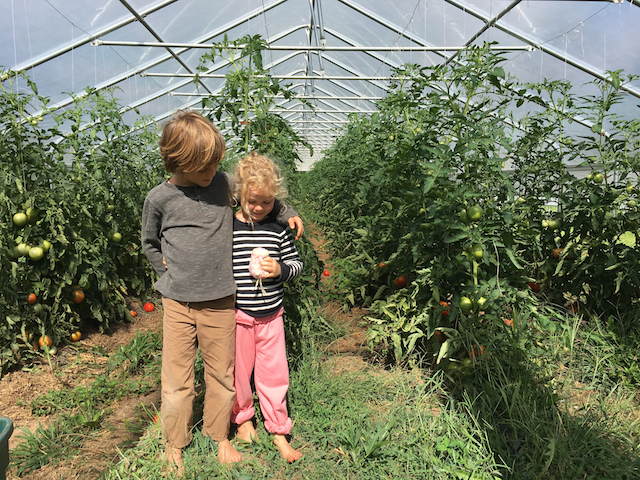
The change in temperatures has us thinking about fall outside, but inside the hoop tunnel the 2nd planting of tomatoes is just starting to get going.
To me, leeks and potatoes mean fall is here. We will receive both for several weeks (or months) to come.
Leeks can be stored unwashed loosely wrapped in plastic in the crisper drawer of the fridge for 2-3 weeks. They can also be frozen by washing and slicing them, then air drying on the kitchen counter. Place on a tray and freeze, then place in plastic bag. Use in soups, stews and other delicious dishes. Leeks are just practically interchangeable with onions and scallions in most dishes.
Potatoes do not like it hot, cold, light, or too humid – so, store them in a cool, dry, dark place. Cool as in not near the stove or heating vents (but not in the refrigerator). Dry and dark in a cupboard or pantry that's not near the sink and is frequented enough where they won't be forgotten. A ventilated and dry basement is also a good option.

August 30, 2020
Time to Preserve for Winter
By Linda Dansbury
Time to Preserve for Winter
By Linda Dansbury
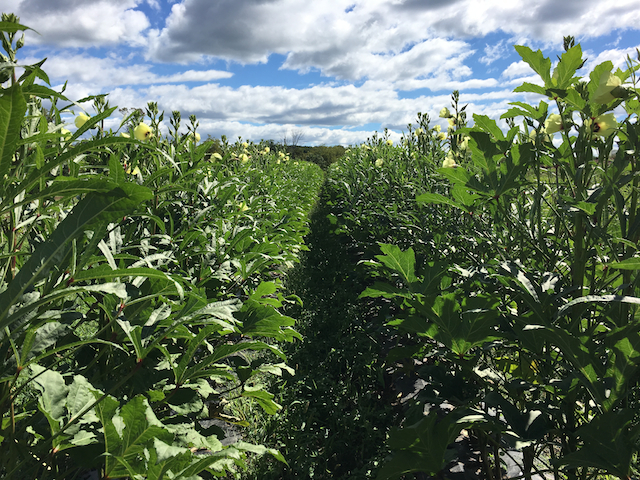
Okra forest, now more than 6' tall.
As I am writing this, the weather has broken and it is a gorgeous morning outside. I find that my mind and body start to crave different foods when the days start to get even slightly shorter – longer cooked, more warming foods. Although I am still eating a lot of “summery” foods, I have started to transition somewhat. Let me know how you are enjoying your harvest at lindadansbury@comcast.net and please put Anchor Run in subject line so I can find your email.
Onions, Peppers, Garlic, herbs – the peppers from the farm were accumulating, and I also have a lot of them coming along in my own garden, so I had to do something with a good number of them – I made chili and it is a large batch!
Watermelon, tomato, herbs – made the Heirloom Tomato, Watermelon and Feta Cheese recipe on this site – Yum!
Okra, sweet pepper, onion – I did a new dish with okra. Quickly fried whole okra. Meanwhile, sautéed pepper and onion till soft and added Sambal Oelek – quite a bit of it to the pan and moved it all around until combined – really a yummy snack.
Okra, onion, pepper, hot pepper, garlic, eggplant, dandelion greens – made a veggie stew. Started with the onion and pepper and sautéed till starting to soften. Added chopped up eggplant and cooked until it was carmelizing a bit, then added chopped up okra. When that was almost cooked, I added corn from a leftover ear and the chopped dandelion greens. Added a bunch of herbs at the end.
Edamame – I mostly cooked and ate as snacks right away, but the latest batch I froze. After cooking, lay out on a kitchen towel to drain well. Place on cookie sheet and put in freezer until frozen and then place in resealable plastic bag to use later in the year.
Lemongrass, garlic, mint, lettuce, cilantro, parsley, scallion – we did lamb kebabs – recipes are all over the internet, but instead of putting them on wooden skewers, we used the stalks of lemon grass – it imparted such a nice taste! The version of kebabs included a yogurt sauce that had minced garlic and mint. Served alongside a salad of greens and lots of herbs. A really nice, light delicious summer dish that I would serve to anybody.

August 30, 2020
Ready for this Change
by Farmer Derek
Ready for this Change
by Farmer Derek
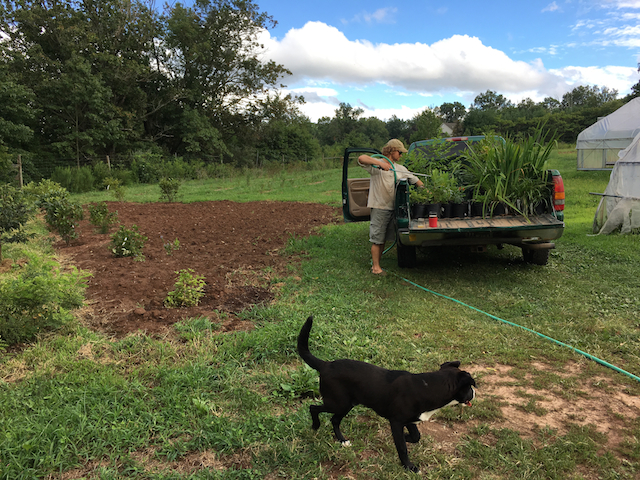
Playing with plants during a Saturday evening break from farm work. Ever tire of lawn and its high maintenance requirements and minimal environmental benefits? Convert it into something else that gives back to nature by using native plants.
Last week was a productive and busy one. We finally managed to finish weeding the fall carrots, which were also cultivated for the 3rd time. Additional potatoes were dug. Finished fields were sown with a cover crop mix of buckwheat, oats, and winter wheat. Field space was readied for our two new caterpillar tunnels. Because we're locating these at the bottom of a field with our heaviest soil and poorest drainage and at the bottom of the hill, we had to grade and create waterways while elevating the plots for the tunnels. (Interestingly, this soil type does extremely well in protected environments where moisture is controlled.) I had to prepare a similar site in the same field for our longer, bigger hoop tunnel in 2017 so this time was a bit easier and went a lot quicker. Before Friday's rain event we sowed fescue, perennial rye, and white clover in the waterways. Last week we also transplanted a lot of crops including arugula, head lettuce, romaine lettuce, endive, escarole, salad radishes, hakurei turnips, kale, beets, chard, and napa cabbage. We seeded the first crops for indoor fall and winter production including kale, head lettuce, lettuce mix, and chard. We also converted a grass area into a plot for a variety of native plants. And of course we also spent a lot of time harvesting, washing, and distributing shares. During this coming week we have more to seed, transplant, harvest, weed, clean up, maintain, and dismantle. Enjoy this weather!

August 23, 2020
Greens Party
by Farmer Dana
Greens Party
by Farmer Dana

First planting of fall greens thriving and ready for harvest.
Harvest #15 (Week A) should include cantaloupe, winter squash, scallions, basil, tomatoes, eggplant, sweet peppers, onions, garlic, kale, swiss chard, hot peppers, okra, italian dandelion, and shishito peppers. U-pick should include edamame, cherry/grape tomatoes, husk cherries, tomatillos, flowers, and herbs. We'll probably give lettuce a break this week to allow it to mature more; kale and chard should be plentiful. Blackberries have some kind of blight and may be unavailable.

August 23, 2020
Workshifts for Week of 8/24/20
by Farmer Derek
Workshifts for Week of 8/24/20
by Farmer Derek

An Io moth caterpillar on a young black locust sapling.
Workshifts will be held rain or shine. If it's raining we'll probably process garlic in the barn. When it's dry we'll probably harvest potatoes or pull some weeds.
Workshifts scheduled for this week:
- Tuesday 8/25 8-10am
- Wednesday 8/26 9-11am
- Wednesday 8/26 6-8pm
- Friday 8/28 9-11am
- Sunday 8/23 7-9am

August 23, 2020
Future Plans
by Farmer Derek
Future Plans
by Farmer Derek
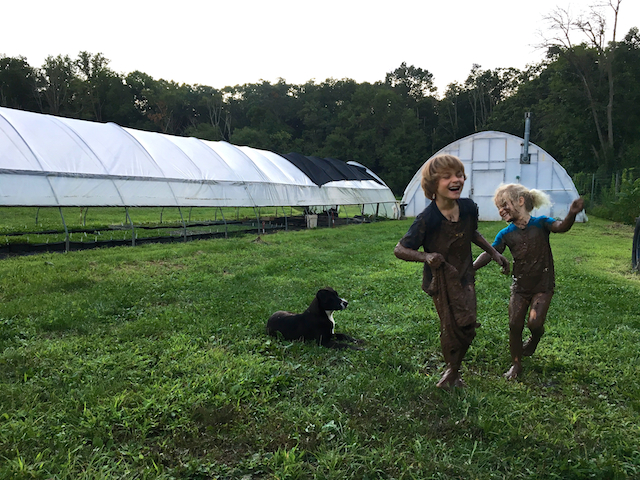
While parents considered site details for two new tunnels, mud was found and put to good use.
It may be that we're still stuck in summer, occasionally enveloped in thick humidity and blasted by hot sunshine. Nevertheless we're pushing our minds forward up the number line towards cooler weather and shorter days. The time for sowing seeds for outdoor crops has passed; we're now seeding for indoor, protected space growing in our numerous tunnels for fall and winter production. Even though it feels like we're still in the midst of summer - and we are - diminishing daylight over the next few months really slows down plant growth and we need to prepare for November, December, January harvests now. Crops sown now, transplanted late September will be harvested in November. Crops sown in September and transplanted in early October will be harvested in December or early January. Crops sown and transplanted any later will barely grow and won't be harvestable until mid/late February, too late for our growing seasons. From mid-November through end-January daylight drops below an important 10-hour/day mark and plant growth slows remarkably. Well established plants will continue to grow at a diminished rate, but young plants will mostly just sit in a dormant state. It takes a bit of a mind overhaul to switch mental gears from summer to winter growing plans, especially when one makes those plans in the opposite season. But with practice and good record keeping it gets easier.
On that note we decided to invest in two additional tunnels for the farm, albeit slightly less permanent ones that are theoretically movable. They will provide an additional 4800 square feet of protected space, increasing those farm environments by more than 50%. A big part of our motivation for this investment was to better control growing crops on the shoulders of the Main Season, especially for May and November harvests. This past April and early May was way too cold and drastically slowed down outdoor crop growth. October and November can vary significantly year to year and just a slight change in temperatures in the colder direction can impair crop production and harvestability. For example, a 35-degree medium frost compared to a 30-degree heavy frost can render crops unharvestable. 'Simply' putting crops in a tunnel gives them a 10-degree or so buffer. Adding another layer of fabric on the inside can basically pull them through the worst of winter all without supplemental Earth-sourced heat - thanks to the Sun for fusing hydrogen into helium 94,000,000 miles away!
In the here and now we're thankful for a return of the big leafy greens kale and chard. With decent weather these crops should be around for most of the rest of the season. We're also thankful for some dry weather. It's been pretty wet the past 1.5 months. We're also appreciative of member help harvesting potatoes and weeding the fall carrots. Depending on one's disposition, either or both of those tasks could be hard to enjoy, but we've made some great progress on both tasks. The carrots will probably be all cleaned up this week while the potatoes will slowly be chipped away at. We plant 5 varieties with different maturities so that we don't have to harvest all of them at the same time.

August 23, 2020
2020 Late Fall and 2021 Main Season
by Farmer Derek
2020 Late Fall and 2021 Main Season
by Farmer Derek
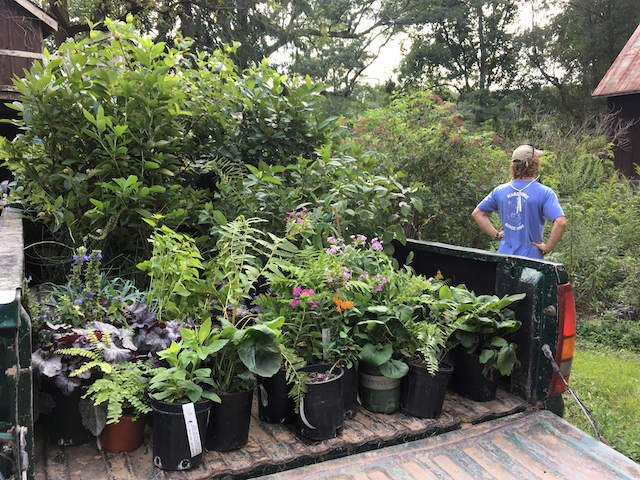
A truck full of native plants for the farm!
Registration will open for both the 2020 Late Fall and 2021 Main Season simultaneously in September. Late Fall membership will be limited to current CSA members. 2021 Main Season registration will open to current members, then the Waiting List, then the general public. Due to the pandemic and other factors, we anticipate strong demand for both seasons which will be filled on a first-come-first-serve basis. We'll announce via e-mail and you'll be able to join through the website.

August 16, 2020
Harvest Update, A Reckoning
by Farmer Derek
Harvest Update, A Reckoning
by Farmer Derek
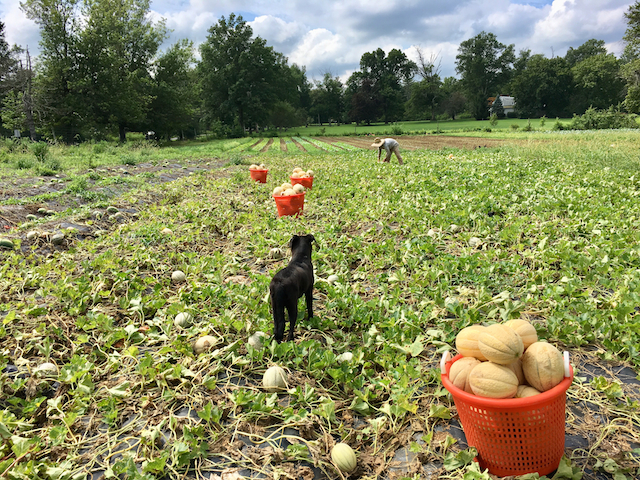
It's been a good melon year. Both plantings of watermelon survived and yielded well enough to distribute for 4 weeks, I believe for the first time in 12 years. We're picking cantaloupe from the 2nd planting right now and these should take us through at least this week and into next. Timing, for us, is crucial for these crops. There's only a small window to achieve crop maturity before migrating-from-the-south disease arrives in northern areas. Our goal is to plant the 1st batch of watermelon around the frost-safe date in early May then plant every 1-2 weeks after for a total of 4 successions of watermelon plus cantaloupe. Since we choose not to rely on sprays to control pests and diseases we proactively use preventative measures like row cover, rotation, timeliness, fertility, raised beds, weed control fabric, and drip irrigation. Seen in the background are rows of fall crops: beets, chard, kale, and napa cabbage.
We're in the midst of a transition, a departure, a lessening (with a lesson) of certain crops. Some crops have met their potential and leave us feeling satisfied with their yield. Others have us scratching our heads as we try to understand what undermined their success. Let's not over- or understate the challenge of growing hundreds of varieties of crops over a 9-month growing season. The plethora of variables beyond our control, those we choose not to control because we farm organically, is a daunting list but one which must be assessed when goals aren't met. Crops whose seasons are ending but overall met their yield expectation include watermelon, cucumbers, and zucchini. It's been nice being able to rely on them for the past 1 and 2 months. What I'm most disappointed by is the nosedive drop in tomatoes. From a peak haul of 1,500lbs two and a half weeks ago to barely enough to cover Thursday and Saturday pick up last week is maddening. A quick consultation of past seasons shows me that tomatoes peak somewhere betweend 7-10lbs/member for a week or week and a half then for the next 2-3 weeks provide 4-6lbs then end with 2-3 pounds for a few weeks. So, why such a quick decline this year?
I believe it's a disease issue which could be one or more of the following: anthracnose, alternaria, septoria leaf spot, verticillium wilt. It feels like it's recurring, unfortunately. Last year the field tomatoes had the healthiest foliage on the biggest plants we've had, yielded well very briefly, and also declined rapidly. We practice a minimal 3+ year crop rotation, use covered raised beds, keep plants elevated/trellised to minimize any soil contact and splashing. But, I think, our weakness lies in our unsterilized trellising method. We use 7-foot t-posts and aluminum wire to support the plants and it's possible a disease organism is overwintering on one of those materials. Pruning and clipping means we're in amongst the plants regularly so if a plant is sick the illness can easily spread. Plant stress also can exacerbate susceptibility to illness but the tomatoes this year enjoyed pretty good conditions (except for more recently). July was very hot, humid, and wet, so that could provided too much stress. I'll be thinking this over and will hopefully come up with a solution for next year. Fortunately our 2nd planting of tomatoes, in the hoop tunnel, is starting to ripen and will hopefully yield well enough to satisfy everyone (that is if we can keep the armyworm larva population under control).
Eggplant is another crop that has me perplexed. Big, healthy plants, a good yield for a couple of weeks in the beginning, then just a trickle for the past few weeks. Bookending tomatoes and eggplant in the same field are okra and sweet peppers, crops that are performing as well as expected and look healthy overall.
Thus, we apologize for crops that aren't abundant like they should be.

August 16, 2020
Try New Herbs!
By Linda Dansbury
Try New Herbs!
By Linda Dansbury
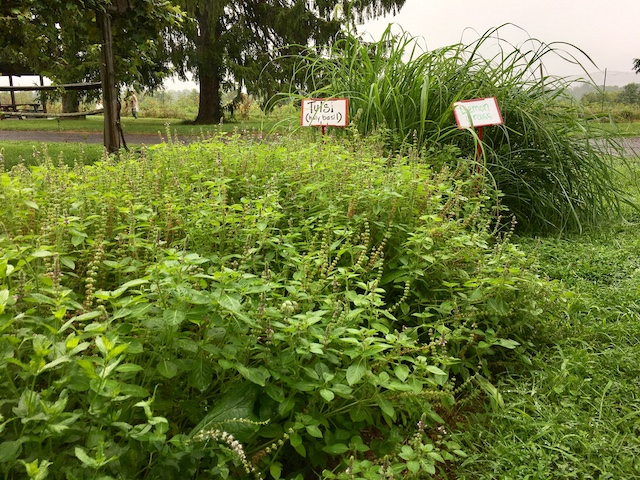
Tulsi/Holy Basil and Lemongrass in the northeast corner of the herb garden.
As many of you know from my writings, I love cooking and eating Southeast Asian, and in particular Thai food. There are two herbs in the herb garden which seem overlooked by members: Lemongrass and Holy Basil or Tulsi. As with many other herbs, both of these have both medicinal and culinary uses and benefits. Lemongrass and Holy Basil are both used to make teas and many commercially available teas contain lemongrass as part of the mix. Both herbs reportedly help lower stress and anxiety. You can google each of them to learn more about their medicinal uses. Lemongrass, as it sounds, has a nice lemony aroma and flavor with a hint of ginger and mint. The tulsi variety of holy basil is peppery and crisp, with hints of lemon, peppermint and cloves.
From a culinary standpoint, they are both necessary components in Thai dishes, and Holy Basil is also used in Indian cuisine, and is in fact where the plant originated. The part of the lemongrass that is used in cooking is the lower 1-2" of the stem. Look for the thickest stems and with a very sharp knife or pruner (or a delicate pull and twist), cut the stalk at the base of the plant. Take off the tough outer leaves and the top part of the plant. The inner part has a purple coloring: this is the part of the stalk that is the best to use. Typically in Thai food lemongrass is one component of pastes that can contain garlic, chili peppers, shallots, ginger, and more. A mortar and pestle is traditionally used, but a food processor can also be employed. To provide you with a recipe, I am adding a recipe for Vietnamese Lemongrass Chicken. Almost any protein would work well with this recipe.
Holy Basil or Tulsi is not a familiar herb to most people. Rather than shiny, its leaves are a bit fuzzy. The leaves are used in Thai stir fry dishes, as an aromatic with garlic, fish sauce and chilies to impart flavor into meat, fish, or chicken. Holy basil is best used fresh, as its leaves cannot maintain their aroma after a few days in the refrigerator. I also found that it doesn't hold up in a glass full of water, which is different than the Italian or Thai basils. I typically add the whole leaves at the end of making the stir fry. If it is added early in making the dish, the heat will cause the flavor to diminish, much like what happens with other fresh herbs such as parsley.

August 16, 2020
Workshifts for Week of 8/17/20
by Farmer Derek
Workshifts for Week of 8/17/20
by Farmer Derek
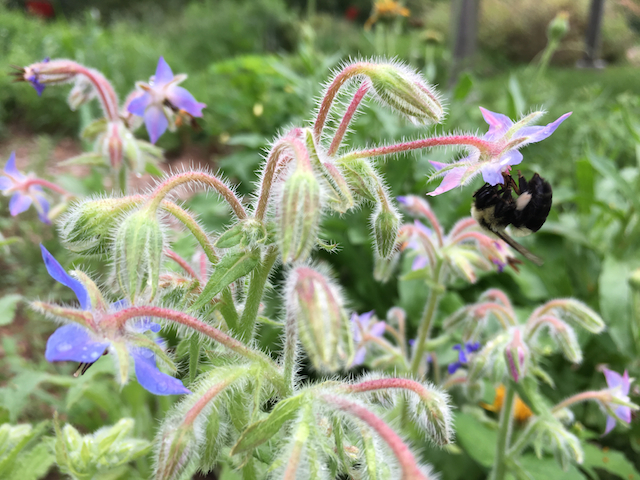
A bumblebee foraging for nectar on an edible cucumber-esque borage flower in the herb garden.
Workshifts will be held rain or shine. If it's raining we'll probably process garlic in the barn. When it's dry we'll probably harvest potatoes.
Workshifts scheduled for this week:
- Friday 8/21 8-10am
- Sunday 8/23 7-9am

August 16, 2020
Land Giveth
By Farmer Dana
Land Giveth
By Farmer Dana
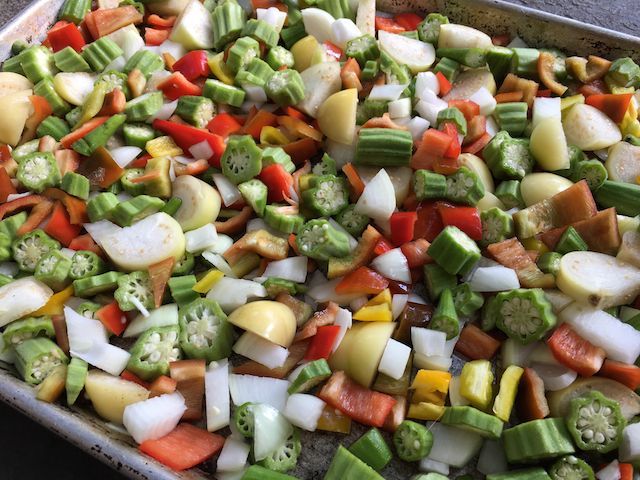
Okra, tomatillos, onions, sweet peppers tossed in bacon fat (or olive oil), a splash of apple cider vinegar, and salt, and roasted at 400 degrees for an hour. Easy, tasty veggie side dish.
Harvest #14 (Week B) should include cantaloupe, carrots, scallions, garlic, sweet peppers, winter squash, lettuce, onions, basil, tomatoes, eggplant, cucumbers, zucchini, hot peppers, shishito peppers, okra, and Italian dandelion. Some items will be choice. Tomato and eggplant yield is currently down; cucumbers and zucchini are at the end of their season. U-pick should include tomatoes, edamame, husk cherries, tomatillos, blackberries, herbs, and flowers.

August 16, 2020
New things to Eat
By Linda Dansbury
New things to Eat
By Linda Dansbury
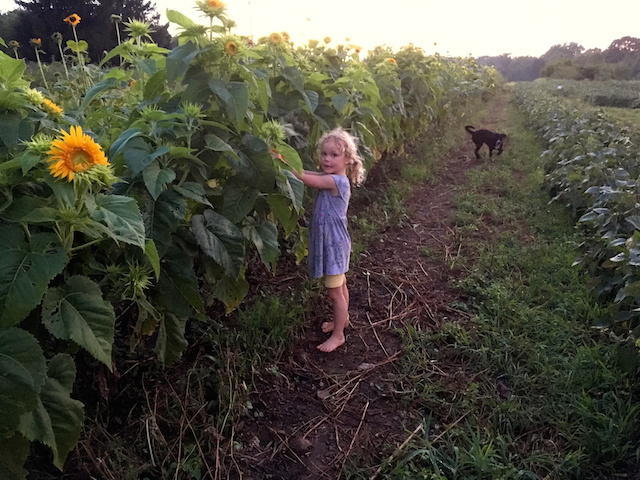
Collecting sunset sunflowers.
I was pretty adventurous and motivated to cook this past week, trying some new recipes. I would love to hear from you and share with the rest of our members how you enjoyed your harvest too, so please email me at lindadansbury@comcast.net and put Anchor Run in the subject line.
Tomatoes, lettuce, garlic, zucchini - made the Warm Sausage Salad with Zucchini that is on this site. This is a simple and delicious dinner salad. I normally make it a few times during the season, but forgot about the recipe until this week.
Okra - tried a new dish in which you quick fry the okra in neutral oil, just till it turns bright green, about 1 minute. Drain the okra. The pods were bigger this week, so I sliced them on the bias into about 1 1/2 to 2" pieces. While the okra was frying, in a wok I put a little oil, and a tablespoon or 2 of Sambaal Oelek and stir fried it till aromatic. Added a bit of sugar to it, then added the okra which had been fried into the wok and stir fry. Add a tablespoon or so of oyster sauce and a little salt. Toss, place in bowl and top with one or more of thinly sliced chili peppers, fried onions or shallots and roasted peanuts.
Holy Basil, lemongrass, garlic - made a chicken wing dish that started with marinading the wings for a bit, and in a mortar and pestle making a seasoning mix consisting of lemongrass, hot peppers, garlic, onion, ginger. Chicken was browned, then boiled till the water evaporated. Seasoning mix was added and all was cooked together until wings were cooked. Removed from heat and added a few large handfuls of holy basil. Yum.
Green beans, cherry tomatoes, onion, herbs - saw a method for grilling the green beans - yes, you need to be careful about it - that turned out amazing. Grilled the beans and then made it into a salad with the tomatoes, some onion, herbs and a sherry vinegar vinaigrette.
Watermelon, cucumber, mint - made a very simple salad which also used lime juice and pepper and a bit of feta added on the top. Served with spicy bar-b-que ribs and the counter balance was delicious.

August 9, 2020
"Fruitful" Time of the Year!
By Linda Dansbury
"Fruitful" Time of the Year!
By Linda Dansbury
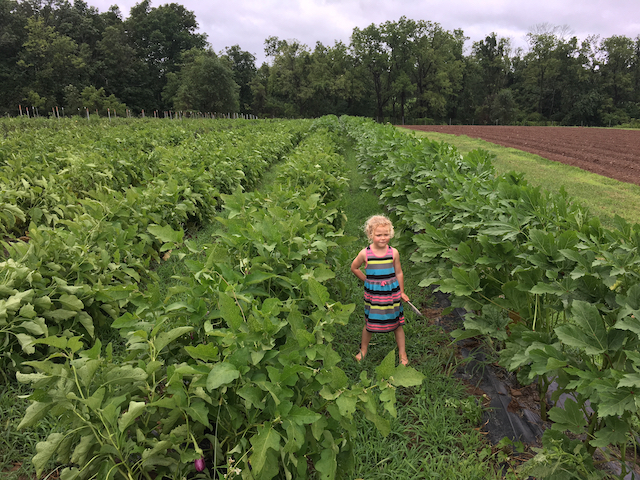
Eggplant and okra blowin' in the wind as Isaias departs.
I am loving the fruit part of our share! The watermelon is so, so sweet, the blackberries sweet and tart at the same time - I just received my cantaloupe yesterday so haven't cut into it yet but the fragrance is amazing. Check out Member Ideas and Suggestions for a simple blackberry recipe.
We continue to enjoy having Caprese Salads and Bruschetta, alternating days, as I have previously written. I am making different versions of Zucchini Bread and freezing it for simple desserts later in the year. See below for a few other things I did this week - and please send me how you are enjoying the harvest at lindadansbury@comcast.net - and please put Anchor Run in the subject line.
Onion, garlic, zucchini, basil - we are enjoying our zucchini by doing variations on simply sauteing them. Dice up some onion; mince or grate garlic; saute until lightly browned. Add zucchini cut into matchstick sized pieces, into zoodles, or just sliced - how large the pieces are defines how long the zucchini needs to cook. I am loving the zoodles, because they basically just get warmed up. Add toasted nuts and chopped fresh herbs to "dress it up".
Okra - slice into coins, heat olive oil and drop Okra pieces in. Brown on one side, then turn over and brown on the other side. Drain on paper towels and immediately salt and eat - be careful, these are an addictive snack!!
Peppers, Onions, herbs - had breakfast for dinner - sauteed peppers and onions until nice and soft and slightly browned. Added beaten eggs and cooked until cooked but not completely firm. Topped with some grated cheese and had a nice local sausage with it.
Watermelon, tomato, basil, mint, hot pepper, onion - made the Watermelon, Heirloom Tomato and Goat Cheese Salad from this site. Refreshing and delicious!

August 9, 2020
Onion and New Crop Info
By Linda Dansbury
Onion and New Crop Info
By Linda Dansbury

Spaghetti squash curing in the greenhouse.
Everyone knows what to do with onions, but storing them is another thing - the onions we are receiving are considered storage onions, but according to Derek the "safest" way to store them is in the fridge. I have been doing this for years and the onions really do keep well in the fridge.
Spaghetti squash will come with our shares in the next couple weeks, as the cucumber and zucchini start to dwindle. Spaghetti squash typically store pretty well in a cool, dry place such as a basement. If there are any knicks or bruises, use them up quickly so they don't rot. The best way I have found to cook the squash is to preheat oven to 400 degrees. Carefully cut the squash in half lengthwise. Scoop out the seeds and save to roast for a yummy snack. Place the squash cut side down in a baking pan - I find putting water in the bottom helps cook the squash more evenly. Bake for 30 min and check for done-ness. When ready, a fork will easily go through the flesh to the peel. You can taste it and if too crunchy, cook for another 15 minutes. Length of baking depends on size of the squash. Pull the strands of the squash gently with a fork. Place in bowl and serve with a little olive oil or butter, salt and a sprinkle of herbs, or use in one of the recipes on this site. For August, I like the Spaghetti Squash with Sauteed Tomatoes and Basil.

August 9, 2020
Member and Farmer Suggestion
By Linda Dansbury
Member and Farmer Suggestion
By Linda Dansbury

The best way we've found to temporarily store freshly harvested parsley, papalo, and basil - in a jar with water. In addition to staying fresh, they're like mini bouquets to admire as you use them through the week.
Fellow member Carrie Meunch (who has sent in ideas other years) sent me a note and recipe - she made the crockpot Chile Verde for dinner and then found a simple Blackberry Cobbler to make. I am posting it for you all to try. Cobblers are great because they are simple and the fruit is somewhat interchangeable. I made a Blueberry Buckle from a recipe from another fellow member, Robin Hoy, and I did half blueberries and half blackberries - wow, so yummy!
Thank you so much Carrie for sharing!
Dana and Derek are not only amazing farmers, they also have some great ideas about enjoying the harvest. Derek said on his night to cook, he heated the oven to 375 degrees. He tossed the okra - whole - didn't even trim the tops off - placed on cookie sheet and let them roast for an hour. He said it was the best okra he ever had - crispy on the outside and tender on the inside. I can't wait to try this for myself.

August 9, 2020
For Our Members
by Farmer Dana
For Our Members
by Farmer Dana
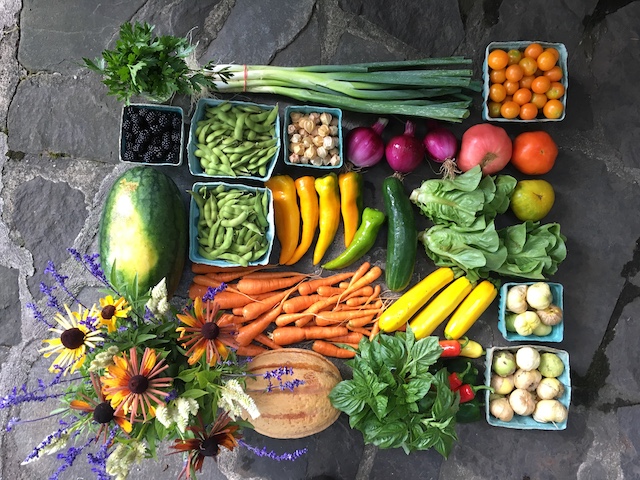
Harvest #13 (Week A) should include cucumbers, zucchini, cantaloupe, watermelon, carrots, tomatoes, onions, eggplant, sweet peppers, lettuce, scallions, basil, hot peppers, okra, shishito peppers, dill, and Italian dandelion. U-pick should include cherry/grape tomatoes, edamame, tomatillos, husk cherries, snap beans, flowers, and herbs.

August 9, 2020
Workshifts for Week of 8/10/20
by Farmer Derek
Workshifts for Week of 8/10/20
by Farmer Derek
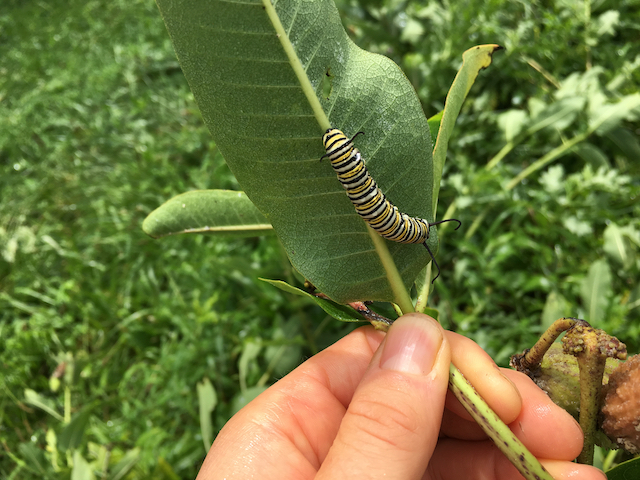
Monarch larva on milkweed.
Workshifts will be held rain or shine. If it's raining we'll probably process garlic in the barn.
Workshifts scheduled for this week:
- Friday 8/14 8-10am
- Sunday 8/16 7-9am

August 9, 2020
Time to Dry Out
by Farmer Derek
Time to Dry Out
by Farmer Derek
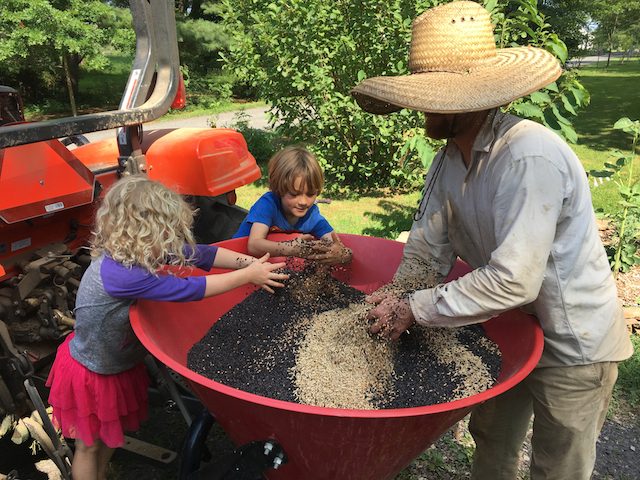
The highly technical and precise science of blending cover crop seeds.
Last week was punctuated by Isaias. I hope you fared well. We were relatively lucky here, only receiving 2.8" of rain, some gusty wind blasts, and a few fallen trees and branches. Not far from us 7" of rain fell and many folks lost power, so overall we made it through relatively unscathed. The worst event from last week was probably the malfunctioning of our cooler system where all of our 2,500 pounds of onions were being stored. Of course it also broke down on Monday morning when there is no time available to devote to the problem until late in the day. Fortunately replacement parts arrived by week's end and function was restored. I did move all those onions into the walk-in cooler temporarily, and now they'll have to be moved back. Soon they'll be joined by potatoes in that less humid storage room.
Last week's wet weather kept us from accomplishing some of our normal weekly tasks like transplanting and cultivating but there were plenty of other jobs to keep us busy. Tuesday we mostly stayed out of the hazardous weather while the other days were spent harvesting, weeding, pruning and trellising, mowing, weed wacking, touring, and seeding.
Carrot seeds have begun germinating and popping up to meet the sun, as well as the acres of cover crops sown last weekend.
This week we'll hopefully have enough time to dry out before the next rain event so that we can cultivate where needed as well as transplant many thousands of fall seedlings including beets, chard, lettuce, kale, kohlrabi, napa/chinese cabbage, dill, and cilantro.
Might as well give a shout out to our new waterways, Jim the 'dozer operator, and the surveying and designing NRCS of the USDA provided. Where there used to be erosion and water woe was nothing but safe soil bliss. Permanent conservation, sustainability improvements meeting expectations are a wonderful thing.

August 2, 2020
August Shares
by Farmer Derek
August Shares
by Farmer Derek
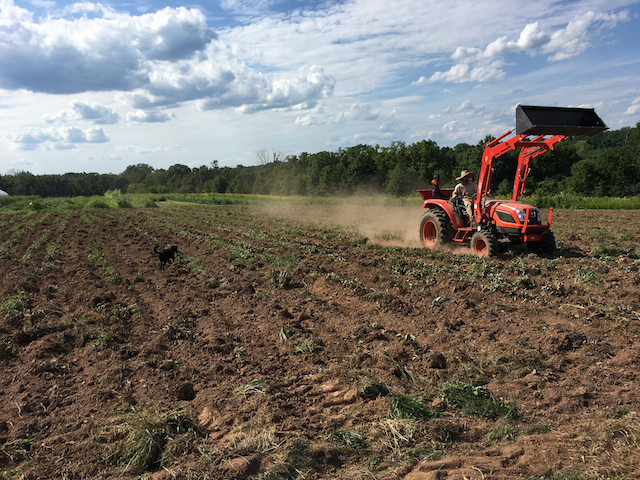
Remember those spring peas and strawberries? That area was transformed into space for fall cover crops (unharvested grain/legume species that protect and nurture the soil).
What a week. I'm tired but pulling energy from deep within, from somewhere, from the future because there is eventual rest there. Borrowing. Monday is normally the most difficult day of the week. Not just because the weekend is over, which is basically just a time for different work, and the official work week begins, but because harvests are huge and heavy right now and it's the day cucumber and zucchini harvest coincides with an actual pick up day so harvest morning becomes harvest afternoon. Binning shares the way we are this year also means that two of our staff need to break for lunch and be ready to pack by 12:30pm. Added to Monday last week was an epic tomato yield. Seven hundred pounds of heirlooms came out of the high tunnel and 800 pounds of red slicers were harvested in the field. The prior harvest day, Thursday, yielded about a third of that weight, and this peak caught us by surpise. Hey, but rejoice, fresh tomatoes are a summertime treat, a thrill! In my mind I associate early August with peak tomatoes, but perhaps I need to adjust that brainwave to the end of July since that's when it's occurred this year and last. Oh, and it was super hot, like borderline unsafely hot. But we persevered and will.
This is a great time of year. Early August marks the halfway point between the summer solstice and the fall equinox and daylight hours will quickly reduce and hopefully the worst heat is behind us. Large contiguous areas of spring and early summer crops are now available for cover crops, which is what I spent all day Saturday preparing for. Timing matters and when a perfect opportunity presents itself I try to take advantage. Perhaps I even get excited by the prospect of putting those fields to sleep for the winter which largely removes them from management and active thinking for the next half year. That's if the sown seeds take and we get a good stand of desired plants. I flail mow, chisel plow, broadcast the seeds (in this case it was oats, wheat, and buckwheat), then disc harrow them in. The chisel penetrates the soil a good 8" deep every 12" across the 7-foot implement, loosening and fracturing but without too much negative disturbance, and the disc penetrates 2-3" every 6" across, chops up residue, and mixes the seeds into the soil. It's the best and quickest method for us to convert spent 'cash' crop fields into cover cropped fields. Dry conditions followed by ample rain are ideal. On Saturday I was also able to sunrise sow another mile of carrots, destined for a mid-fall harvest. I also upgraded/improved a waterway at the top of the u-pick field below the ranch house where excess water has been bothering crops and me.
Upcoming this week is a hurricane, harvesting, a farm tour, weeding, transplanting, seeding, cultivating, and mowing.

August 2, 2020
Such a Good Time
by Farmer Dana
Such a Good Time
by Farmer Dana
Harvest #12 (Week B) should include watermelon, basil, lettuce, cucumbers, zucchini, carrots, scallions, tomatoes, sweet peppers, eggplant, onions, hot peppers, okra, and Italian dandelion. Some items will be a choice. U-pick should include cherry/grape tomatoes, edamame, snap beans, tomatillos, husk cherries, blackberries, flowers, and herbs. U-pick reminder: Open 8am-8pm Mon-Sun.

August 2, 2020
Workshifts for Week of 8/3/20
by Farmer Derek
Workshifts for Week of 8/3/20
by Farmer Derek
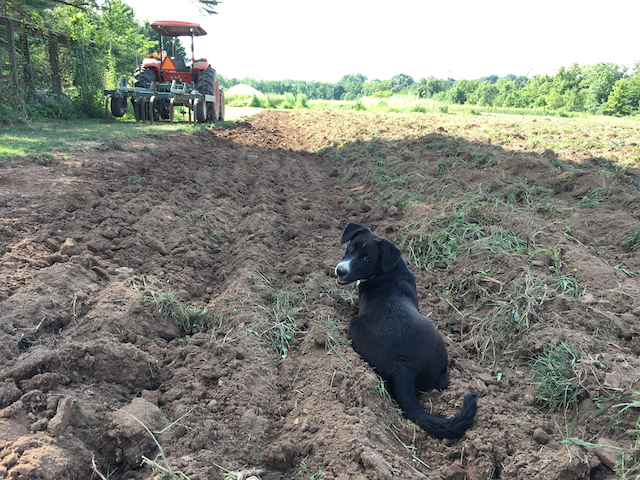
Finch rests in the valley of the improved and hopefully fully functional waterway.
Workshifts scheduled for this week:
- Friday 8/7 8-10am
- Sunday 8/9 7-9am

August 2, 2020
**Workshop 8/23** Now What… Did you do with your share?
by Gia Yaccarino
**Workshop 8/23** Now What… Did you do with your share?
by Gia Yaccarino
Hosted by longtime farm and core group member Gia Yaccarino.
Please join me Sunday, August 23, from 1-3pm at the Pavilion (a rain-out make up date from 8/16).
Wow – This has been one crazy year – both for the world and at the farm! I think we all have settled into our “farm routine” for this growing season – but it is a vastly different routine from previous years! At least for me. And as I take a step back to consider the differences, I of course think of the things I am missing at the farm.
Sorrel! I miss the Sorrel! I love that “lemon lettuce”!
I also miss the “community” part of the CSA – the talking in the pick-up room as we patiently wait to weigh out our share. Passing the time while doing the U-Pick by talking to other members. And the potlucks - YUM! (We have some excellent cooks at the farm!!!) I miss you guys – the other farm members that I felt a camaraderie with as we all attempted to find creative ways to use our plentiful shares of produce. I understand – with the current state of things, people are giving each other space – lots of space – thank you. But, still- I miss the community!
So let’s have a workshop!
If you have been a member, prior to this year, you probably remember that I usually run a “Now What” workshop at the start of the season. This year, I want to add a twist – since we are already 10 weeks into the season, I also want my fellow members to contribute what they have done with their shares. Successes, Disasters (we learn from our mistakes!), Misadventures! Are you stuck in a rut and do the same thing with certain vegetable?
I will also be talking about using a dehydrator, since that always seems to be a popular topic!
Please bring a notepad and pen or pencil to take notes!
Please Join me Sunday, August 23, from 1-3 at the Pavilion.

August 2, 2020
Tomato Days!
By Linda Dansbury
Tomato Days!
By Linda Dansbury
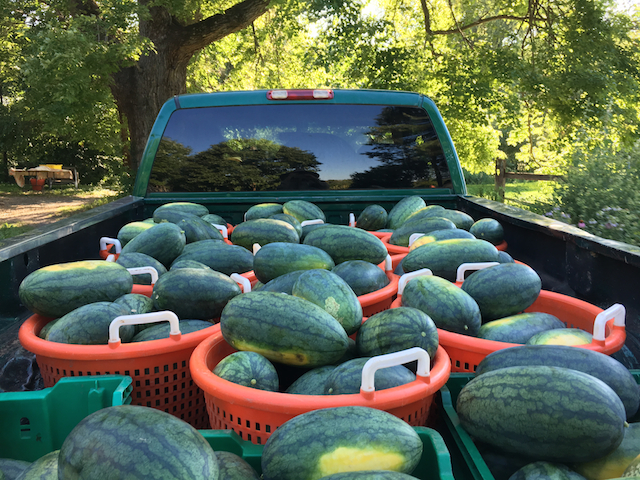
One of many truck loads of melons coming out of the field!
Tomato days are here and that is so, so exciting! They are so delicious that I don't do too much with them. I know a lot of people do their Caprese (aka tomato and mozzarella) salads with either balsamic vinegar or even a balsamic glaze, but I simply dress the tomatoes with a drizzle of good olive oil, salt, pepper and basil - the flavors are just perfect! We alternate this with bruschetta - again, keeping it simple so the tomatoes are what shines. Here is a bit of how we enjoyed the harvest - please share what you are doing with your harvest by emailing me at lindadansbury@comcast.net and put Anchor Run in the subject line so that I see your email.
Tomatoes, garlic, onion or scallion, basil, peppers - I love making the tomato salad I grew up eating when garden tomatoes were in season. Peel the tomatoes and cut into bite sized chunks, chop peppers into small bites, slice onion or scallion thinly, tear or chiffonade basil, and grate a bit of garlic - grating makes the garlic a bit milder than chopping or mincing and you don't want an over-powering flavor. Place everything in a bowl and salt and pepper to taste, add a bit of oregano, then drizzle a little red wine vinegar and olive oil and mix well, but gently because the tomatoes are delicate without their skins. Enjoy - an added treat is to dunk bread into the dressing - oh my! What a delicious treat.
Tomatillos, garlic, hot pepper, papalo (substitute for cilantro; it's in the herb garden) - made the Tomatillo sauce for the Chicken Stew with Tomatillo Sauce with 2 weeks worth of my tomatillos and placed in freezer for use later. I really like having things to pull out of the freezer in the middle of the winter.
Zucchini, cherry tomatoes, basil, garlic - made an uncooked tomato sauce and put over warmed Zoodles - we have 2 recipes on this site - just type tomato sauce into the search bar on the recipe section of this site.
Eggplant, zucchini, onion, greens, garlic, peppers - a blend of hot and sweet - I made the Veggie Fritters recipe sent by fellow member Ashmali Patel. It was a fun and delicious way to use the veggies!
Cucumbers - made Narrow Bridge Farm Refrigerator Pickles - these keep for a couple of weeks in the fridge and require no canning.

August 2, 2020
More new Crops
By Linda Dansbury
More new Crops
By Linda Dansbury
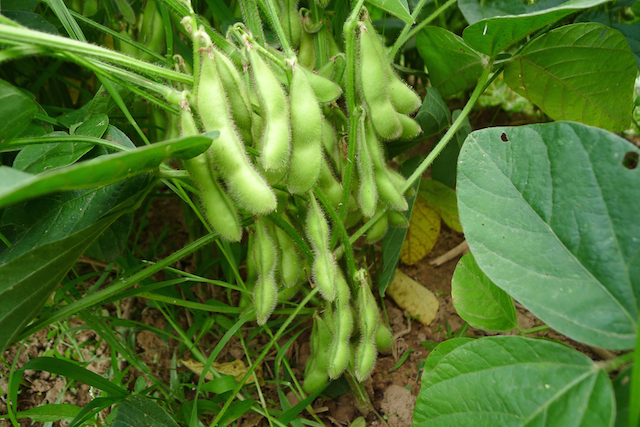
Edamame (green soybean) on the plant, ready for pickin'.
One of the favorite farm crops should be ready for this week - edamame. Very nutritious and a fun, healthy snack to eat. Look for the plumpest beans to be at the bottom of the plants. Use 2 hands when pulling the pods off the plant, so you don't remove the entire branch. Fresh edamame should be eaten or frozen within a week. Store the pods in a perforated plastic bag in the fridge. To freeze, bring a large pot of heavily salted water to a rolling boil and have a bowl of ice water ready. Boil the beans for about 3 min, drain and place in ice water. Once they cool down, place on a towel to drain. I place the bean pods on a cookie sheet, and place in freezer until frozen. Then place in a plastic bag or container.
To snack on, boil the pods in heavily salted water for 9-12 min, checking for done-ness starting at 9 minutes. Drain well, salt again and enjoy! There are a lot of recipes on this site for edamame - so take a look and enjoy.
Okra made it's first appearance this past week. People in line waiting to pick up commented that they don't know what to do with it. One of the simplest and most delicious things to do is to put a bit of oil in a pan. Slice the okra into "coins". Place in hot oil and cook until browning. Turn over and continue cooking until browned on both sides. Remove from pan, salt and enjoy - Okra Chips!
Something I do every year with okra and other veggies is to make batches of veggie stew. I start by sauteing onion, I add garlic and then whatever veggies I want to use, including okra, eggplant, zucchini, peppers, tomatoes that may have gotten over ripe, corn and greens and allow to simmer until the flavors meld together and the veggies are softened. Spices such as cumin can be added, as can a hot pepper. Stock or canned tomatoes can also be added - I like this to be a bit saucy. I freeze it in serving size containers and then pull it out during the year to enjoy over brown rice, along with grilled sausages, as a topping for fish, chicken or pork, etc. There are also several delicious okra recipes on this site. One of my favorites is the Easy Indian-Style Stewed okra.
Enjoy the harvest.
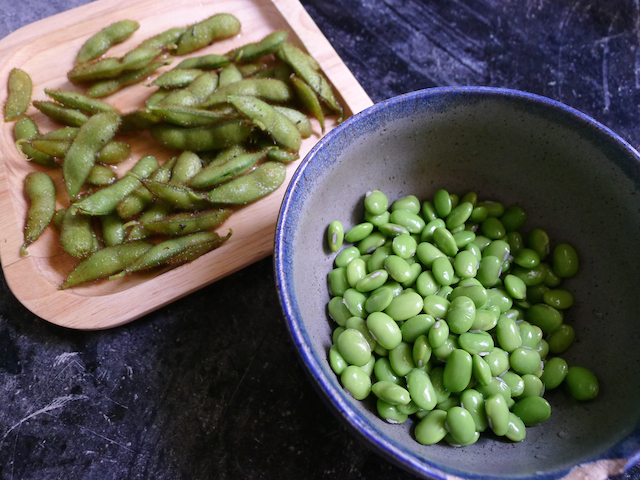
Cooked edamame, a perfect snack.

August 2, 2020
COVID Etiquette Reminder
by Farmer Dana
COVID Etiquette Reminder
by Farmer Dana
Per the PA Department of Health:
"In Pennsylvania, masks must be worn whenever anyone leaves home. Masks are mandatory in all public spaces. Members of the public should wear homemade cloth or fabric masks and save surgical masks and N95 respirators for health care workers and first responders."

August 2, 2020
BCFA Farm Tour Wednesday 7pm
By Farmer Dana
BCFA Farm Tour Wednesday 7pm
By Farmer Dana
We're hosting a Bucks County Foodshed Alliance farm tour this Wednesday at 7pm. Follow this link for more information.

POSTS BY TYPE
POSTS BY MONTH

